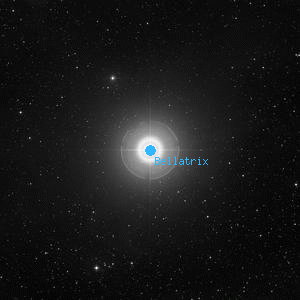Bellatrix

Overlaid DSS image of Bellatrix, 60' x 60' with north at top and west to the right
Aladin viewer for the region around Bellatrix
Gamma Orionis, γ Ori, 24 Ori
BD+06 919, HD 35468, HR 1790, WDS J05251+0621, SAO 112740, HIP 25336
BD+06 919, HD 35468, HR 1790, WDS J05251+0621, SAO 112740, HIP 25336
| Type | Star |
|---|---|
| Magnitude | 1.64 | Right Ascension | 5h 25' 7.9" (2000) |
| Declination | 6° 20' 59" N |
| Constellation | Orion |
| Classification | B2V |
Observing Notes
Andrew Cooper
Sep 28, 2020 Waikoloa, HI (map)
20cm f/6 Newtonian, Cave Astrola @ 76x
Seeing: 7 Transparency: 7 Moon: 0%
Brilliant blue-white, no companion noted
Captain William Henry Smyth
Nov 7, 1838 No. 6 The Crescent, Bedford, England (map)
150mm f/17.6 refractor by Tully 1827
A bright star, with a minute distant companion, on Orion's right shoulder; and it is one of ♅.'s insulated objects. A 2, pale but clear yellow; B 15, grey; a third star precedes by about 34s, in the sp quadrant.
γ Orionis was rejected from the Greenwich List in 1830, there being no fewer than four others of this constellation retained as standards : it is called Bellatrix, or the female warrior, and is the smaller of the two upper stars in Orion. The gender of this star puzzles Hood, who knoweth not why it should be female, "excepte it be this, that women born under this constellation shall have mighty tongues." Bellatrix is the Al-nájid, or subduer, of the Alphonsine Tables; but Ulugh Beigh calls it Al-mirzam al-nájid, though other Asiatic astronomers give the first epithet, Al-mirzam, to α Orionis. Hyde, in his notes on Ulugh Beigh (Syntagma I. 59), explains the Arabic words as signifying "the conquering lion;" but his interpretation is doubtful.
γ Orionis is the north-west star of the four at the corners of this asterism, so to speak; and an ideal line, carried from Sirius over Aldebaran to the Bull's ear, passes over it in the mid-distance; the rhymester then directs,From Bellatrix now pass a line,A friend considered my distance as "much too large," and the colour of A to be "reddish." On referring to Mr. Challis, that gentleman examined the object with the great Northumberland equatoreal, pronounced A to be "yellowish," and made the following measures:
to Betelgeuze the red,
And, to the north, three little stars
will mark Orion's head.Pos. 148°04' Dist. 180".46 Ep. 1841.19Bellatrix has a small though sensible movement in space; but the doctors differ respecting its amount and direction. Thus the values of those most worthy of attention are the following:
[WDS 144° 178".00 2009 ]P.... RA -0".17 Dec. -0".03
B.... +0".09 +0".01
[Hipparcos -0".00811 -0".01288]― A Cycle of Celestial Objects Vol II, The Bedford Catalogue, William Henry Smyth, 1844
Other Data Sources for Bellatrix
Nearby objects for Bellatrix
4 objects found within 60'
| C 0524+070 | Dolidze 17 | |
| NGC 1875 |
Credits...
Drawings, descriptions, and CCD photos are copyright Andrew Cooper unless otherwise noted, no usage without permission.
A complete list of credits and sources can be found on the about page
Bellatrix